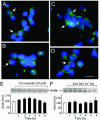Pituitary adenylate cyclase-activating polypeptide prevents the effects of ceramides on migration, neurite outgrowth, and cytoskeleton remodeling
- PMID: 15695581
- PMCID: PMC549011
- DOI: 10.1073/pnas.0409681102
Pituitary adenylate cyclase-activating polypeptide prevents the effects of ceramides on migration, neurite outgrowth, and cytoskeleton remodeling
Abstract
During neuronal migration, cells that do not reach their normal destination or fail to establish proper connections are eliminated through an apoptotic process. Recent studies have shown that the proinflammatory cytokine tumor necrosis factor alpha (and its second messengers ceramides) and the neuropeptide pituitary adenylate cyclase-activating polypeptide (PACAP) play a pivotal role in the histogenesis of the cerebellar cortex. However, the effects of ceramides and PACAP on migration of cerebellar granule cells have never been investigated. Time-lapse videomicroscopy recording showed that C2-ceramide, a cell-permeable ceramide analog, and PACAP induced opposite effects on cell motility and neurite outgrowth. C2-ceramide markedly stimulated cell movements during the first hours of treatment and inhibited neuritogenesis, whereas PACAP reduced cell migration and promoted neurite outgrowth. These actions of C2-ceramide on cell motility and neurite outgrowth were accompanied by a disorganization of the actin filament network, depolarization of tubulin, and alteration of the microtubule-associated protein Tau. In contrast, PACAP strengthened the polarization of actin at the emergence cone, increased Tau phosphorylation, and abolished C2-ceramide-evoked alterations of the cytoskeletal architecture. The caspase-inhibitor Z-VAD-FMK, like PACAP, suppressed the "dance of the death" provoked by C2-ceramide. Finally, Z-VAD-FMK and the PP2A inhibitor okadaic acid both prevented the impairment of Tau phosphorylation induced by C2-ceramide. Taken together, these data indicate that the reverse actions of C2-ceramide and PACAP on cerebellar granule cell motility and neurite outgrowth are attributable to their opposite effects on actin distribution, tubulin polymerization, and Tau phosphorylation.
Figures









Similar articles
-
PACAP and ceramides exert opposite effects on migration, neurite outgrowth, and cytoskeleton remodeling.Ann N Y Acad Sci. 2006 Jul;1070:265-70. doi: 10.1196/annals.1317.024. Ann N Y Acad Sci. 2006. PMID: 16888176
-
Opposite regulation of the mitochondrial apoptotic pathway by C2-ceramide and PACAP through a MAP-kinase-dependent mechanism in cerebellar granule cells.J Neurochem. 2004 Dec;91(5):1231-43. doi: 10.1111/j.1471-4159.2004.02810.x. J Neurochem. 2004. PMID: 15569266
-
Pituitary adenylate cyclase-activating polypeptide prevents C2-ceramide-induced apoptosis of cerebellar granule cells.J Neurosci Res. 2003 May 1;72(3):303-16. doi: 10.1002/jnr.10530. J Neurosci Res. 2003. PMID: 12692897
-
Role of PACAP in controlling granule cell migration.Cerebellum. 2009 Dec;8(4):433-40. doi: 10.1007/s12311-009-0121-9. Epub 2009 Jun 23. Cerebellum. 2009. PMID: 19548046 Review.
-
The neurotrophic activity of PACAP on rat cerebellar granule cells is associated with activation of the protein kinase A pathway and c-fos gene expression.Ann N Y Acad Sci. 1998 Dec 11;865:92-9. doi: 10.1111/j.1749-6632.1998.tb11167.x. Ann N Y Acad Sci. 1998. PMID: 9928001 Review.
Cited by
-
Neuroprotective actions of cerebellar and pineal allopregnanolone on Purkinje cells.FASEB Bioadv. 2020 Feb 5;2(3):149-159. doi: 10.1096/fba.2019-00055. eCollection 2020 Mar. FASEB Bioadv. 2020. PMID: 32161904 Free PMC article. Review.
-
Changes in the expression of PACAP-like compounds during the embryonic development of the earthworm Eisenia fetida.J Mol Neurosci. 2008 Nov;36(1-3):157-65. doi: 10.1007/s12031-008-9102-6. Epub 2008 Jul 8. J Mol Neurosci. 2008. PMID: 18607777
-
Granule cell survival is deficient in PAC1-/- mutant cerebellum.J Mol Neurosci. 2008 Nov;36(1-3):38-44. doi: 10.1007/s12031-008-9066-6. Epub 2008 Apr 12. J Mol Neurosci. 2008. PMID: 18409023
-
Differential gene expression and functional analysis implicate novel mechanisms in enteric nervous system precursor migration and neuritogenesis.Dev Biol. 2006 Oct 1;298(1):259-71. doi: 10.1016/j.ydbio.2006.06.033. Epub 2006 Jun 27. Dev Biol. 2006. PMID: 16904662 Free PMC article.
-
Chronic stress increases pituitary adenylate cyclase-activating peptide (PACAP) and brain-derived neurotrophic factor (BDNF) mRNA expression in the bed nucleus of the stria terminalis (BNST): roles for PACAP in anxiety-like behavior.Psychoneuroendocrinology. 2009 Jul;34(6):833-43. doi: 10.1016/j.psyneuen.2008.12.013. Epub 2009 Jan 31. Psychoneuroendocrinology. 2009. PMID: 19181454 Free PMC article.
References
-
- Tojima, T. & Ito, E. (2004) Prog. Neurobiol. 72, 183-193. - PubMed
-
- Ye, P., Price, W., Kassiotis, G., Kollias, G. & D'Ercole, A. J. (2003) J. Neurosci. Res. 71, 721-731. - PubMed
-
- Bieberich, E., MacKinnon, S., Silva, J. & Yu, R. K. (2001) J. Biol. Chem. 276, 44396-44404. - PubMed
-
- Toman, R. E., Movsesyan, V., Murthy, S. K., Milstien, S., Spiegel, S. & Faden, A. I. (2002) J. Neurosci. Res. 68, 323-330. - PubMed
-
- Falluel-Morel, A., Aubert, N., Vaudry, D., Basille, M., Fontaine, M., Fournier, A., Vaudry, H. & Gonzalez, B. J. (2004) J. Neurochem. 91, 1231-1243. - PubMed
Publication types
MeSH terms
Substances
LinkOut - more resources
Full Text Sources
Molecular Biology Databases
Miscellaneous

